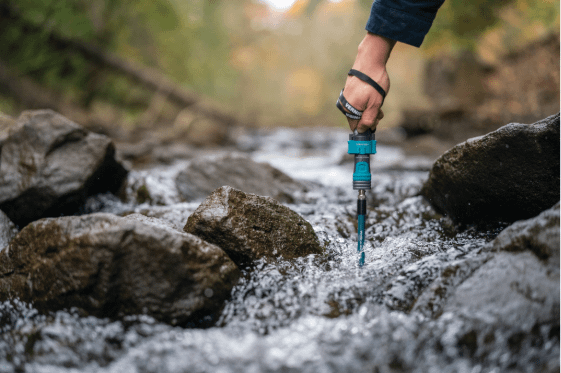Shop
- Training
- Webinars
Webinars
Our webinars offer innovative ways to engage students with STEM in traditional classroom or virtual environments. Our experienced educational technology specialists will walk you through experiments that students can do using our free sample data.
Upcoming Webinars
The Dirt on Soil Science: Engaging Experiments with Go Direct Sensors

May 1, 2024
4:00–4:45 p.m. PDT | 7:00–7:45 p.m. EDT
Make the most of the warm weather by taking your environmental science class outside! Join Vernier environmental science expert Colleen McDaniel as she explores four sensors that can help your students investigate the world at their feet. From identifying moisture needs for plants to comparing ecosystems and even digging into microorganisms and decomposition—these sensors can help you find new ways for students to engage in hands-on scientific study. You’ll also get a chance to see a demonstration of the new Go Direct® Soil Moisture sensor!
Introduction to Water Quality Testing with Vernier

May 14, 2024
4:00–5:00 p.m. PDT | 7:00–8:00 p.m. EDT
As the sun returns and students eagerly await outdoor learning opportunities, it is the perfect time to explore water quality testing with Vernier sensors.
Join Vernier Biology and Environmental Science Educational Technology Specialist Colleen McDaniel and Director of Chemistry Dr. Melissa Hill as they demonstrate how students can use Go Direct® sensors to investigate common water quality factors, such as dissolved oxygen, pH, and conductivity. Have your students collect data from various water sources, analyze the results, and propose solutions to improve ecosystem health.
Recent Webinars
Chemistry Essentials: Getting Started with Vernier

Learn about our three most commonly used chemistry sensors and discover innovative ways to make chemistry more relatable and engaging for your students. In this webinar, cChemistry experts Dr. Melissa Hill and Nüsret Hisim cover the sensors your students can use to investigate concepts like acid-base reactions, gas laws, reaction rates, and more.
Examining the Evidence: How Probeware Supports Three-Dimensional Learning

Are you looking to enhance three-dimensional science learning and deepen student engagement in your school or district? Explore the latest research on the impact of probeware technology in STEM labs and classrooms. We’ll also cover strategies for effective technology implementation and ideas for getting started with Vernier Connections™.
Inspiring Students to Think Like Physicists with Hands-On Data Collection and Real-World Modeling

Learn how you can use real-world phenomena and hands-on data collection to awaken students’ curiosity and inspire them to think like physicists!
Getting Ready for the Total Solar Eclipse with Dave Vernier

Are you ready for the total solar eclipse on April 8, 2024? The eclipse presents a rare opportunity to explore this celestial phenomena with hands-on science and engage your students with real-world learning! Join our Co-Founder Dave Vernier for an informative session to help you prepare to observe this event safely and collect exciting scientific data with Vernier sensors.
The Fluorescence Files: Exploring Chemistry Concepts through Forensics

Turn your classroom into a forensics lab and help your students solidify their understanding of chemistry concepts! Join Vernier chemistry specialist Nüsret Hisim in an NSTA-hosted webinar as he shares his classroom-tested techniques for sparking engagement through hands-on forensics experiments. After discussing tips and best practices, Nüsret will cover an experiment from our new lab book, Forensic Chemistry Experiments, which provides a ready-to-implement forensic investigation into ink pigment identification using Vernier spectroscopy tools.
Motion Three Ways: Experiments with the New Vernier Cart Fan

Investigate force and motion with the new Vernier Cart Fan accessory! Find out how your students can collect force, acceleration, and velocity data by adding these easy-to-use, modular fans to our wireless sensor carts. This versatile tool offers variable force levels to demonstrate concepts like uniform acceleration and Newton’s second law.
Engaging Biofuel Exploration Through Cellulose Breakdown with Vernier and Bio-Rad

Wondering how to demonstrate cellulose breakdown and explain how reaction speed relates to biofuel production amounts. Introduce your students to relevant, real-world topics such as sustainability and renewable energy with this hands-on experiment, “Introduction to Biofuels: Enzyme Action”! Get the tools you need to conduct an engaging quantitative enzyme tracking activity with your students using a standards-aligned method for modeling biomass conversion reactions using Vernier spectrophotometers.
Essential Vernier Sensors for CASE APT Courses

Discover simple approaches for collecting reliable, high-quality data across standards-aligned Agricultural Power & Technology (APT) CASE courses with Vernier technology. Curriculum for Agricultural Science Education (CASE) expert Chelsea Bowen and Vernier technology specialists Tom Smith and John Melville, PhD, highlight the sensors and software CASE educators use to promote hands-on exploration of key agricultural concepts from environmental systems to agricultural engineering.
Enzymatic Explorations: Investigating Solutions for Lactose Intolerance

Looking for an alternative to glucose strips when you teach about lactose and lactase? Find out how you can directly track lactose cleavage and metabolism using Go Direct® CO2 sensors. Join Vernier biology expert John Melville, PhD, as he covers a standards-aligned enzymology lesson with an updated real-world application. This phenomenon-driven investigation will allow students to explore lactase enzyme function firsthand by observing lactose breakdown and sugar metabolism.
Physics Essentials: Getting Started with Vernier

Vernier’s Director of Physics Fran Poodry demonstrates our five most commonly used physics sensors and presents several innovative ways to make physics more relatable and engaging for your students. Learn about the sensors your students can use to investigate Ohm’s law in simple circuits, understand the effects of air resistance on falling coffee filters, or learn about Newton’s third law by connecting the hooks of two force sensors with a rubber band.
Past Webinars
When it comes to on-demand professional development for science educators, we’ve got you covered—explore our online training library today!
Get Personalized Training
Interested in free professional development specific to your needs? Request a free personalized virtual training with our experts.
Don't miss a webinar!
Subscribe to our monthly newsletter, The Caliper.
